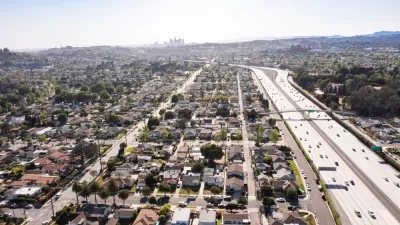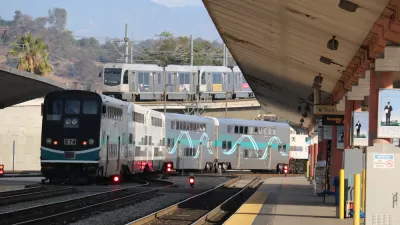Jeremy Rosenberg continues his fascinating series on the laws that shaped Los Angeles with a look at the local, and national, impact of the 1934 National Housing Act on residential development patterns.
In a prior article, Rosenberg examined whether Thomas Jefferson was to blame for L.A.'s sprawl. In this piece, he focuses his attention on the 32nd President.
The Federal Housing Administration (FHA) was created in 1934 by President Franklin Delano Roosevelt and his administration to help the country climb out of the Great Depression by stabilizing the mortgage market. "But, as H. Pike Oliver [senior lecturer and director of undergraduate studies at Cornell University's College of Architecture, Art & Planning] explains, purposefully or not, that's not all the FHA accomplished."
In addition to increasing home ownership nationwide, the FHA also impacted the physical form of residential development through design guidelines that were used to qualify subdivisions for financing, explains Oliver.
"Since states began following the FHA's design guidelines when
crafting their own mortgage-support programs, and since commercial
lenders tended to keep the same guidelines once private dollars started
flowing again, post Great Depression, what began as voluntary aims
became the defacto nationwide design standard," notes Rosenberg.
"And that standard, that shaping, resulted in nothing less than the
nationwide rise of suburbs, subdivisions, single-family homes,
cul-de-sacs, curvilinear streets, homes set far back from streets, grass
lawns in lieu of other planting, the decline of pedestrianism and just
about every other archetypical suburban hallmark."
Returning to the local impact of the law, Oliver contends that, "[t]he effect in Los Angeles was simply due to the massive amount of
development that occurred in the greater Los Angeles area following
World War II. The pace of activity was simply
unparalleled in the history of the nation to that point."
FULL STORY: The Birth of Sprawl: How Ending the Great Depression Meant Inventing the Suburbs

Alabama: Trump Terminates Settlements for Black Communities Harmed By Raw Sewage
Trump deemed the landmark civil rights agreement “illegal DEI and environmental justice policy.”

Planetizen Federal Action Tracker
A weekly monitor of how Trump’s orders and actions are impacting planners and planning in America.

The 120 Year Old Tiny Home Villages That Sheltered San Francisco’s Earthquake Refugees
More than a century ago, San Francisco mobilized to house thousands of residents displaced by the 1906 earthquake. Could their strategy offer a model for the present?

Ken Jennings Launches Transit Web Series
The Jeopardy champ wants you to ride public transit.

BLM To Rescind Public Lands Rule
The change will downgrade conservation, once again putting federal land at risk for mining and other extractive uses.

Indy Neighborhood Group Builds Temporary Multi-Use Path
Community members, aided in part by funding from the city, repurposed a vehicle lane to create a protected bike and pedestrian path for the summer season.
Urban Design for Planners 1: Software Tools
This six-course series explores essential urban design concepts using open source software and equips planners with the tools they need to participate fully in the urban design process.
Planning for Universal Design
Learn the tools for implementing Universal Design in planning regulations.
Clanton & Associates, Inc.
Jessamine County Fiscal Court
Institute for Housing and Urban Development Studies (IHS)
City of Grandview
Harvard GSD Executive Education
Toledo-Lucas County Plan Commissions
Salt Lake City
NYU Wagner Graduate School of Public Service





























